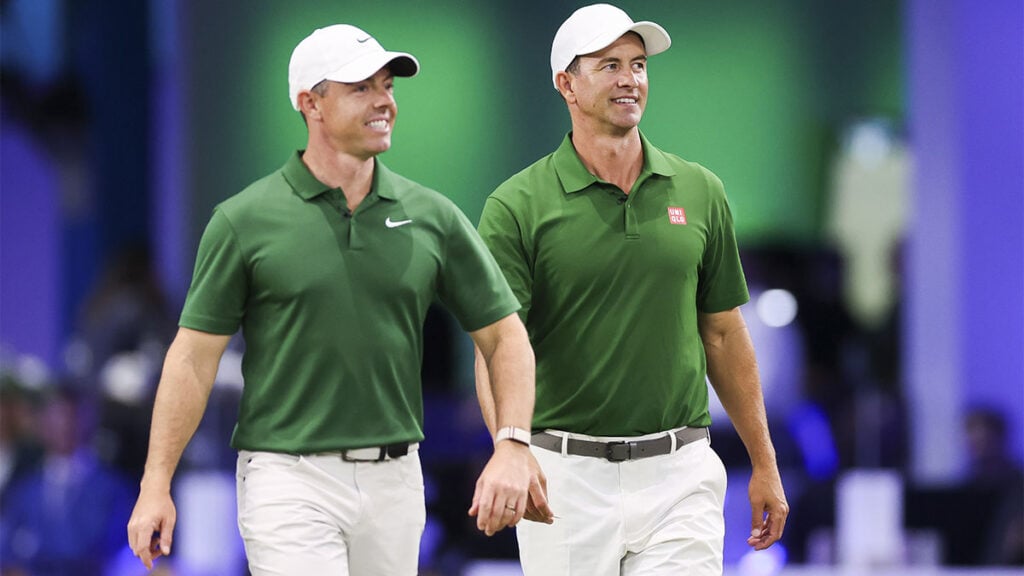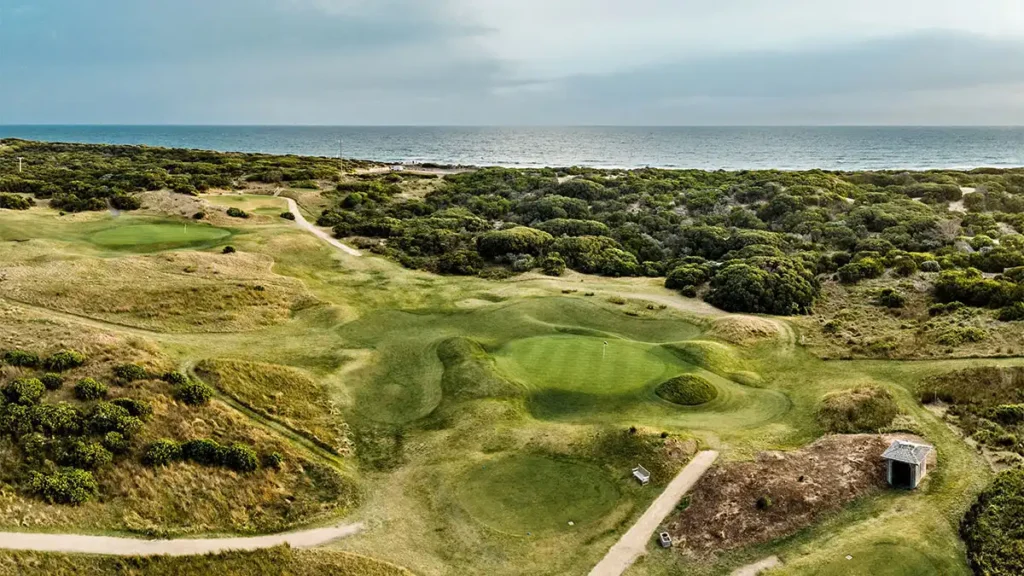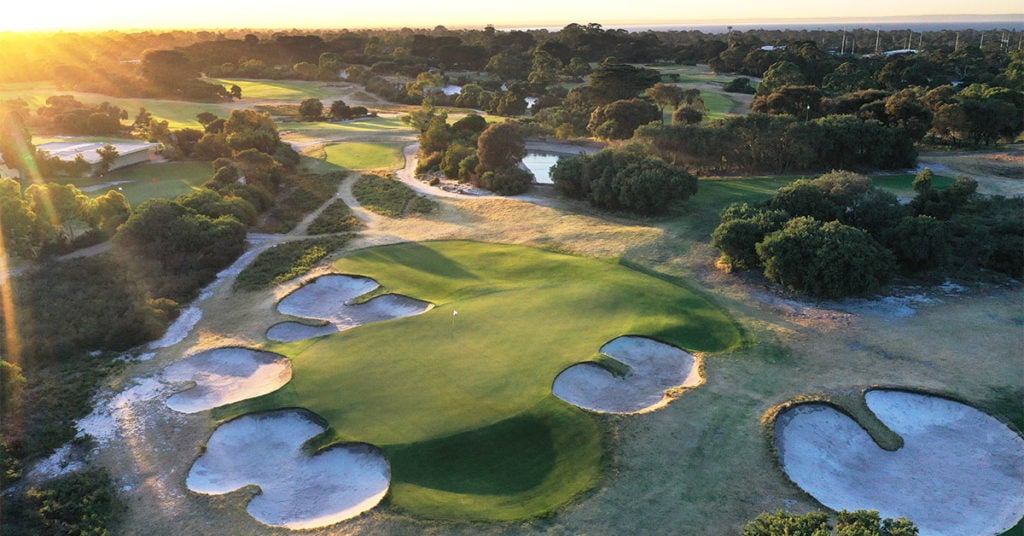They’re good mates – until golf’s ‘fifth major’ is on the line.
Not even Rory McIlroy himself could believe it. It was the final hole of the 2013 Australian Open and Adam Scott – the Masters champion at Augusta National seven months earlier – felt he had one hand on the Stonehaven Cup. Standing on the 18th tee at Royal Sydney with a one-shot lead over the Northern Irishman, Scott was 362 metres away from one of the great years in Australian golf history: the nation’s first ever winner at Augusta in April, then a winner of the Australian PGA and Masters in November. He was staring down a likely Australian Open victory, which would have completed the Australian ‘Triple Crown’, a rare feat possible when the Australian Masters still existed.
Both Scott and McIlroy had struck beautiful 2-irons from the 18th tee, but Scott used about half a club too much on his approach, then hit his ensuing pitch shot far too aggressively and made bogey. McIlroy, who’d flushed a wedge approach to 10 feet, waltzed through the door Scott had opened with a final-hole birdie to claim his maiden Australian Open crown. “I can’t believe I just won,” McIlroy said that day.
Scott still can’t believe it, either, evident when Australian Golf Digest caught up with the former world No.1 via phone. Scott graciously cast his mind back 12 years to that final round at the harbourside course at Rose Bay in Sydney’s east. “It was a bit of a shock finish, because everything had been going my way, I guess, that year, and Sunday was a struggle, but I still had a one-shot lead going down the last,” Scott recalled from his home base in Switzerland. “Thinking back on it now, it’s crazy that that it just flipped like that. It was a bit of a wake-up call [to never lose focus].”
McIlroy had become a household name in 2011, winning the US Open for his maiden major two months after collapsing at that year’s Masters. He captured the 2012 PGA Championship by eight shots for a second career major. But McIlroy switched equipment in 2013 and struggled the entire year, even during the first six holes of that final round at Royal Sydney until the last 12 holes.
“From memory, that was probably the worst year of his career,” Scott recalls. “He’d come off incredible performances in 2011 and ‘12, and then really struggled in ‘13, so I’ll take some credit for putting him back on the right track for the next dozen years after that,” he joked.
Scott was referencing the fact McIlroy’s Australian triumph seemingly spring-boarded him back to enormous heights the next year. He claimed his third and fourth career majors, at the 2014 Open Championship and PGA Championship, respectively, as well as the prestigious BMW PGA at Wentworth.
“He went on to win back-to-back majors, and took himself back to world No.1,” Scott says. “That’s what a win can do; it really can. The confidence you get out of it is like nothing else.”

During an interview for a separate story several years ago, McIlroy told this writer that Scott introduced him to the renowned South Australian shiraz, Penfolds Grange, over a dinner in Sydney that week in 2013. It kicked off a love of Australian red wine for the Ulsterman. Our vineyards and golf courses are two of many reasons McIlroy holds Australia dearly in his heart. He’d spoken openly about his reverence for the Australian Open for several years before he announced his commitment to this year’s championship at Royal Melbourne and next year’s at Kingston Heath.
“Look, I really can’t sit here and take any credit for [McIlroy’s love of Australia], but it’s funny to think back to how young Rory was in 2013,” Scott recalls. “I mean, I was young too, but he was so young [24] at the time, and he was already an international player. [In 2013], I was a little bit older than him, and I was the top player in Australia. He was, and still is, a superstar, and I wanted to make sure he was going to have a good time in Australia.
“By 2013, we’d played a fair bit together; for the first time in 2008 in Qatar when he was still an amateur. We quickly realised we shared a love for playing golf internationally. Rory has always had that drive to play golf around the world and take it all in, whether it’s having Grange in Australia, or in India (McIlroy played the DP World Tour’s India Championship in October) before this Australian Open.
“It’s somewhat similar to me; when I was first out on tour as a pro, playing the European Tour, travelling to a lot of different European cities, being able to stay in the city, I saw what it’s all about. For young golf pros, your education is a kind of a cultural education. You learn the ways of the world.
“Rory and I have a great level of respect for each other, and a professional friendship. We enjoy each other’s company. I want to make sure he has a great trip to Australia this time around as well.”
Surely a great trip, in McIlroy’s eyes, would be lifting the Stonehaven Cup for a second time on the No.5-ranked course in the world (well, the Composite layout at least). For Scott, a dream home summer would no doubt include going down the stretch on the final day at Royal Melbourne against McIlroy, Marc Leishman, Cameron Smith and others, and coming out on top. The 2009 Australian Open winner dreams of becoming a multiple champion. He reveres Royal Melbourne so deeply that he donated the exact set of clubs he used to win the 2013 Masters at Augusta to the famed Sandbelt club, who have it on display in the hallway behind the foyer.
The Australian Open has not been held at Royal Melbourne since 1991, when Scott was 11 years of age and nine years from turning professional. Winning this year would atone for his timeline of heartaches at our national championship, including 2013, as well as a joint runner-up in 2015 and more recently, 2022, when Scott was in the final group at Victoria Golf Club only to finish second to playing partner Adrian Meronk. Scott was also T-4 in 2023.
“The Aussie Open, although I’ve won it, feels a lot more about heartbreak than anything,” Scott says. “I’ve been close so many times, and to only get over the line once is disappointing, and [2013] was a huge disappointment, because there was all the other stuff: I’d won the Aussie Masters and I’d won the PGA, so it would have been cool to win all three that year.
“[My first Australian Open at Royal Melbourne] is huge for me. Winning the Aussie Open at Royal Melbourne is not unlike winning the Open Championship at St Andrews; that’s our Australian holy grail of golf. At this point of the year, the huge focus is to get myself in the best shape possible for Royal Melbourne. I’d love to have a crack at it. I don’t know if we’re going [to get another], or how often it can return after that. I think there have been positive things for the Australian Open over the last 34 years since it’s been there, but one of the negatives probably has been that we haven’t been there for so long. It’s a reminder to Australian golf fans, the world and other players, of the prestige of our Australian Open, not just because of a trophy that has a great list of winners, but with highly regarded venues as well.
“With me wanting to be a great Australian player, a great Australian player wins the national championship more than once. If you look at the greats of the game who I aspire to put myself in a conversation with, Greg Norman has won it five times, Peter Thomson won it three times. Time is running out for me.”
Well, what better time to win a second Australian Open than this year? The problem for Scott is, McIlroy will also be vying for a second Stonehaven Cup at the end of a year in which he’s won the Masters, which completed the career Grand Slam, the Players Championship, the Pebble Beach Pro-Am, the Irish Open and an away Ryder Cup in the US. But for the Australian Open, it’s a great problem to have.
Photography by warren little/getty images • right: brennan asplen/tgl/getty images




